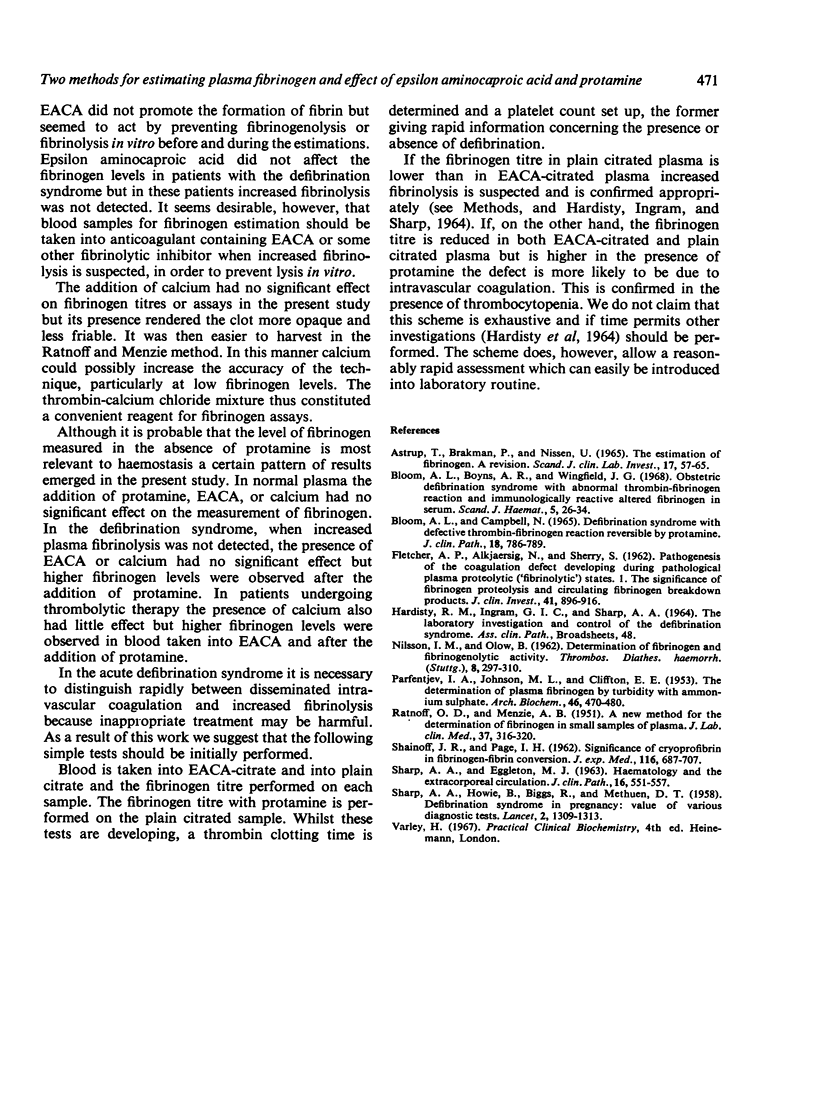Abstract
Fibrinogen concentrations were determined in normal plasma and in plasma from patients with high and low levels. There was a good correlation between the results of a rapid semi-quantitative fibrinogen titre technique and those of a quantitative assay of coagulable fibrinogen. In normal subjects fibrinogen levels were not significantly influenced by taking blood into epsilon aminocaproic acid (EACA) or by the addition of protamine to plasma. In patients with the defibrination syndrome in whom increased plasma fibrinolysis was not detected, fibrinogen levels were not affected by taking blood into EACA but considerably increased levels were observed after the addition of protamine to plasma. In patients undergoing thrombolytic therapy the fibrinogen levels measured were increased both in blood taken into EACA and in plasma containing protamine. It is suggested that EACA acted by preventing lysis in vitro whilst protamine counteracted abnormal fibrin polymerization. The pattern of results may be of diagnostic importance.
Full text
PDF




Selected References
These references are in PubMed. This may not be the complete list of references from this article.
- ASTRUP T., BRAKMAN P., NISSEN U. THE ESTIMATION OF FIBRINOGEN. A REVISION. Scand J Clin Lab Invest. 1965;17:57–65. doi: 10.3109/00365516509077284. [DOI] [PubMed] [Google Scholar]
- Bloom A. L., Campbell N. Defibrination syndrome with defective thrombinfibrinogen reaction reversible by protamine. J Clin Pathol. 1965 Nov;18(6):786–789. doi: 10.1136/jcp.18.6.786. [DOI] [PMC free article] [PubMed] [Google Scholar]
- FLETCHER A. P., ALKJAERSIG N., SHERRY S. Pathogenesis of the coagulation defect developing during pathological plasma proteolytic ("fibrinolytic") states. I. The significance of fibrinogen proteolysis and circulating fibrinogen breakdown products. J Clin Invest. 1962 Apr;41:896–916. doi: 10.1172/JCI104546. [DOI] [PMC free article] [PubMed] [Google Scholar]
- NILSSON I. M., OLOW B. Determination of fibrinogen and fibrinogenolytic activity. Thromb Diath Haemorrh. 1962 Nov 15;8:297–310. [PubMed] [Google Scholar]
- PARFENTJEV I. A., JOHNSON M. L., CLIFFTON E. E. The determination of plasma fibrinogen by turbidity with ammonium sulfate. Arch Biochem Biophys. 1953 Oct;46(2):470–480. doi: 10.1016/0003-9861(53)90218-5. [DOI] [PubMed] [Google Scholar]
- RATNOFF O. D., MENZIE C. A new method for the determination of fibrinogen in small samples of plasma. J Lab Clin Med. 1951 Feb;37(2):316–320. [PubMed] [Google Scholar]
- SHAINOFF J. R., PAGE I. H. Significance of cryoprofibrin in fibrinogen-fibrin conversion. J Exp Med. 1962 Nov 1;116:687–707. doi: 10.1084/jem.116.5.687. [DOI] [PMC free article] [PubMed] [Google Scholar]
- SHARP A. A., EGGLETON M. J. HAEMATOLOGY AND THE EXTRACORPOREAL CIRCULATION. J Clin Pathol. 1963 Nov;16:551–557. doi: 10.1136/jcp.16.6.551. [DOI] [PMC free article] [PubMed] [Google Scholar]
- SHARP A. A., HOWIE B., BIGGS R., METHUEN D. T. Defibrination syndrome in pregnancy: value of various diagnostic tests. Lancet. 1958 Dec 20;2(7060):1309–1312. doi: 10.1016/s0140-6736(58)90579-8. [DOI] [PubMed] [Google Scholar]


